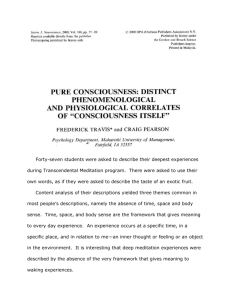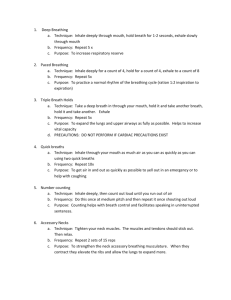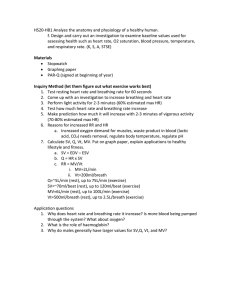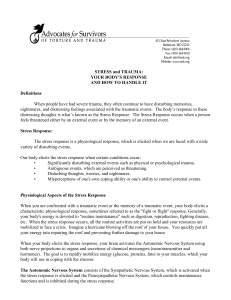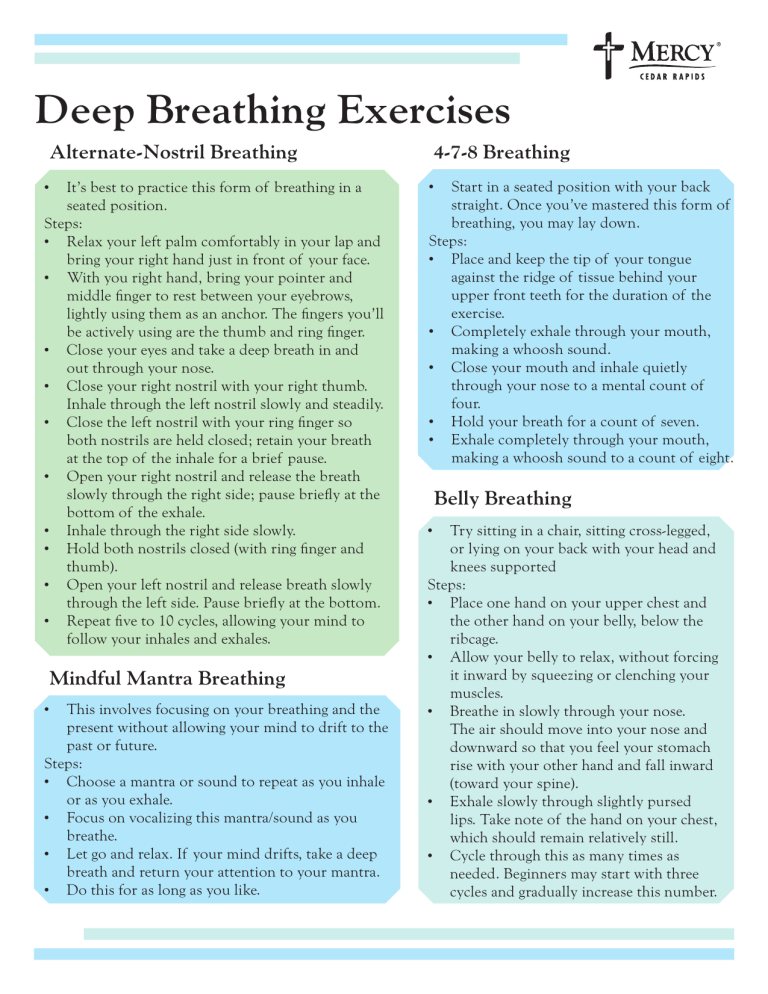
Deep Breathing Exercises Alternate-Nostril Breathing • It’s best to practice this form of breathing in a seated position. Steps: • Relax your left palm comfortably in your lap and bring your right hand just in front of your face. • With you right hand, bring your pointer and middle finger to rest between your eyebrows, lightly using them as an anchor. The fingers you’ll be actively using are the thumb and ring finger. • Close your eyes and take a deep breath in and out through your nose. • Close your right nostril with your right thumb. Inhale through the left nostril slowly and steadily. • Close the left nostril with your ring finger so both nostrils are held closed; retain your breath at the top of the inhale for a brief pause. • Open your right nostril and release the breath slowly through the right side; pause briefly at the bottom of the exhale. • Inhale through the right side slowly. • Hold both nostrils closed (with ring finger and thumb). • Open your left nostril and release breath slowly through the left side. Pause briefly at the bottom. • Repeat five to 10 cycles, allowing your mind to follow your inhales and exhales. Mindful Mantra Breathing • This involves focusing on your breathing and the present without allowing your mind to drift to the past or future. Steps: • Choose a mantra or sound to repeat as you inhale or as you exhale. • Focus on vocalizing this mantra/sound as you breathe. • Let go and relax. If your mind drifts, take a deep breath and return your attention to your mantra. • Do this for as long as you like. 4-7-8 Breathing • Start in a seated position with your back straight. Once you’ve mastered this form of breathing, you may lay down. Steps: • Place and keep the tip of your tongue against the ridge of tissue behind your upper front teeth for the duration of the exercise. • Completely exhale through your mouth, making a whoosh sound. • Close your mouth and inhale quietly through your nose to a mental count of four. • Hold your breath for a count of seven. • Exhale completely through your mouth, making a whoosh sound to a count of eight. Belly Breathing • Try sitting in a chair, sitting cross-legged, or lying on your back with your head and knees supported Steps: • Place one hand on your upper chest and the other hand on your belly, below the ribcage. • Allow your belly to relax, without forcing it inward by squeezing or clenching your muscles. • Breathe in slowly through your nose. The air should move into your nose and downward so that you feel your stomach rise with your other hand and fall inward (toward your spine). • Exhale slowly through slightly pursed lips. Take note of the hand on your chest, which should remain relatively still. • Cycle through this as many times as needed. Beginners may start with three cycles and gradually increase this number. Visualization-Phrase Breathing Steps: • Close your eyes if they’re open. • Take a few big deep breaths. • Breathe in. As you do that, imagine that the air is filled with a sense of peace and calm. Try to feel it through your body. • Breath out. While you’re exhaling, imagine the air leaves with your stress and tension. • Now use a word or phase with your breath. As your breath in, say in your mind, “I breathe in peace and calm.” • As you breathe out, say in your mind, “I breathe out stress and tension.” • Continue for as long as you like. Breath Counting Modified Lion’s Breath Steps: • In a seated position, keep your spine straight and head inclined slightly forward. Close your eyes and take a few deep breaths, then let your breath come naturally. • To begin the exercise, count “one” to yourself as you exhale. • The next time you exhale, count “two,” and so on up to “five.” • Then begin a new cycle, counting “one” on the next exhalation. • Never count higher than “five,” and count only when you exhale. You will know your attention has wandered when you find yourself up to “eight,” “12,” even “19.” • Try to do 10 minutes of this form of meditation. Steps: • Sit comfortably. • Inhale, filling your nose, lungs, and belly with air until you can’t anymore. • As you exhale, rather than breathing out through your nose, open your mouth wide and breathe out with a “HA” sound. • Repeat as many times as needed. Four-Square or Box Breathing Steps: • Exhale to a count of four. • Hold your lungs empty for a four count. • Inhale to a count of four. • Hold air in your lungs for a count of four. • Exhale and begin the pattern anew. Morning Breathing • Try this exercise when you first get up in the morning to relieve muscle stiffness and clear clogged breathing passages. Then use it throughout the day to relieve back tension. Steps: • From a standing position, bend forward from the waist with your knees slightly bent, letting your arms dangle close to the floor. • As you inhale slowly and deeply, return to a standing position by rolling up slowing, lifting your head last. • Hold your breath for just a few seconds in this standing position. • Exhale slowly as you return to the original position, bending forward from the waist. • Notice how you feel at the end of the exercise.


